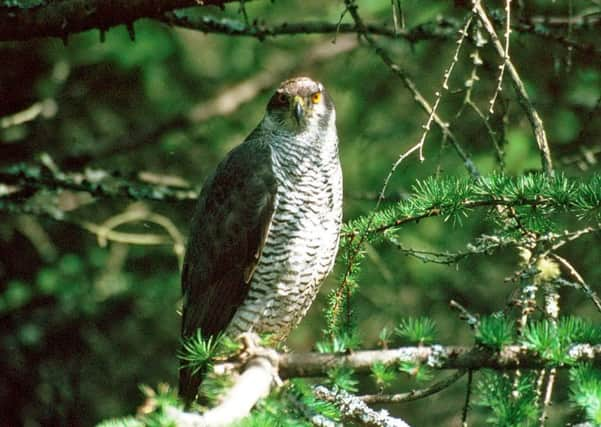Birdwatch: Keeping quiet about region's sightings of persecuted goshawk


The female is much larger than the male – almost buzzard sized – and at first take the lead in courtship, screaming loudly to attract a mate.
Once she has succeeded in doing so the pair will engage in solo or mutual high circling on extended wings and there are also diving and swooping displays.
Advertisement
Hide AdAdvertisement
Hide AdThe male, about the same size as a female sparrowhawk, is blueish grey above while the female is browner and both have barred underparts.
Size is not always easy to judge so goshawks can be confused with the smaller sparrowhawks. Distinguishing features are that goshawks have shorter tails, a wider wing base and, in profile, a much deeper belly.
Spring, when they are displaying, is the best time of the year to watch goshawks which for the rest of the year are notably elusive, staying in dense woodland and gliding through the tree trunks in search of prey.
Goshawks mainly take woodpigeons and squirrels but also pheasants and grouse and this, along with hen harriers, has earned them the unceasing enmity of a section of the gamekeeping fraternity.
Advertisement
Hide AdAdvertisement
Hide AdAs a result, despite heavy fines and in some cases imprisonment, goshawks continue to be trapped, poisoned and their nests destroyed.
The situation is particularly bad in the northern Peak District, once the best place in the country to watch goshawks.
Despite the best efforts of the RSPB and police, including successful prosecutions, the continuing persecution means goshawks have been driven to the edge of extinction in this area.
As a result goshawk sightings in the region, especially at this time of year, are not publicised although most birders know of at least two places to go.
Advertisement
Hide AdAdvertisement
Hide AdWeather fronts put a brake on any large scale arrivals of spring migrants until this week when a southerly airflow promised more arrivals.
A common tern, the first recorded in Britain this spring, was seen over the main lake at Swillington Ings, Leeds on Tuesday, the earliest ever record for the site while across the region there were singing willow warblers, blackcaps and Cetti’s warblers. There were also more sand martin, swallows and garganey ducks.
Avocets were returning to inland sites, there were more ringed and little ringed plovers, and two grey plovers, on their way back to breeding sites in the far north, were seen at Swillington Ings, Leeds and others at North Duffield Carrs, North Yorkshire and Newington Flash, South Yorkshire.
Michael Flowers is still taking bookings for the ten-week Spring birdwatching course starting after Easter. There are most vacancies on Wednesday and Friday afternoons, but limited vacancies available on some other sessions. If you are interested in booking, or for more information contact him at [email protected] or on 07946 625688.